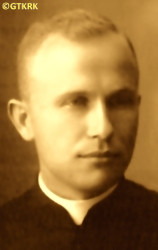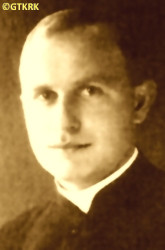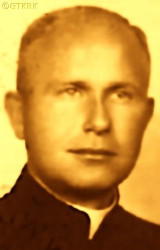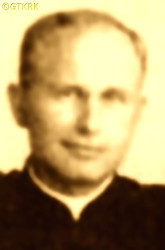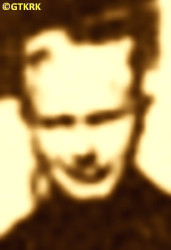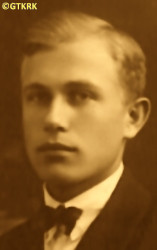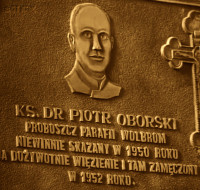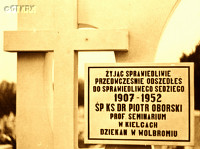Roman Catholic
St Sigismund parish
05-507 Słomczyn
85 Wiślana Str.
Konstancin deanery
Warsaw archdiocese, Poland
full list:
displayClick to display full list

searchClick to search full list by categories
wyświetlKliknij by wyświetlić pełną listę po polsku

szukajKliknij by przeszukać listę wg kategorii po polsku

Martyrology of the clergy — Poland
XX century (1914 – 1989)
personal data
surname
OBORSKI
surname
versions/aliases
OBORA
forename(s)
Peter (pl. Piotr)
function
diocesan priest
creed
Latin (Roman Catholic) Church RCmore on
en.wikipedia.org
[access: 2014.09.21]
diocese / province
Kielce diocesemore on
www.diecezja.kielce.pl
[access: 2012.12.28]
academic distinctions
Doctor of Philosophy
Sacred Theology MA
date and place
of death
18.06.1952

Rawicztoday: Rawicz gm., Rawicz pov., Greater Poland voiv., Poland
more on
en.wikipedia.org
[access: 2021.07.15]
details of death
After German and Russian invasion of Poland in 09.1939, start of the World War II and creation of German–occupied Germ. Generalgouvernement (Eng. General Governorate) evicted on 29.09.1940 from the building of Kielce Theological Seminary — together with other professors.
In 1942 resigned from lecturing in the Seminary.
As the parish priest of Bolmin parish ministered to partisans of independence Home Army AK units (part of Polish Clandestine State).
Lectured at clandestine University of Western Poland in Kielce (part of Polish Clandestine State as well).
After end of military hostilities of the World War II, after commencement of Russian occupation arrested on 19.04.1950 by Russian controlled Commie‐Nazi secret services UB — together with one of his vicars.
Accused of leading an „Undergroud Army” — an anti‐communist organisation of young, lyceum–educating fighters, striving to change by force the political system of the Commie‐Nazi prl (People's Republic of Poland) and inciting the murder of a minor.
Held in Montelupich Str. prison in Kraków.
Pleaded not guilty.
On 22.01.1951 sentenced in Kraków to life imprisonment.
On 01.06.1951 transported to Rawicz and held in jail for political prisoners.
Tortured in prison (a pus sipped from the eyes).
After another two‐week solitary confinement was cruelly beaten up and had internal organs damaged.
Perished in a city hospital, as a result of torture.
cause of death
murder
perpetrators
Russians / Poles
sites and events
RawiczClick to display the description, Cracow (Montelupich)Click to display the description, GeneralgouvernementClick to display the description, Ribbentrop‐MolotovClick to display the description, Pius XI's encyclicalsClick to display the description
date and place
of birth
22.02.1907Birth certification on:
metryki.genbaza.pl
[access: 2025.04.20]

Jastrzębiectoday: Stopnica gm., Busko‐Zdrój pov., Holy Cross voiv., Poland
more on
en.wikipedia.org
[access: 2022.01.28]
alt. dates and places
of birth
10.02.1887
parents
OBORA Ignatius
🞲 ?, ? — 🕆 ?, ?

JANIK Rosalie
🞲 ?, ? — 🕆 ?, ?
baptism
24.02.1887Birth certification on:
metryki.genbaza.pl
[access: 2025.04.20]

Kargówtoday: Tuczępy gm., Busko‐Zdrój pov., Holy Cross voiv., Poland
more on
en.wikipedia.org
[access: 2025.04.20]
St Vladislav the King and Martyr RC church
presbyter (holy orders)
ordination
21.06.1931

Kielcetoday: Kielce city pov., Holy Cross voiv., Poland
more on
en.wikipedia.org
[access: 2021.06.07]
Assumption of the Blessed Virgin Mary RC cathedral churchmore on
en.wikipedia.org
[access: 2025.03.14]
positions held
from 1949
dean — Olkusztoday: Olkusz gm., Olkusz pov., Lesser Poland voiv., Poland
more on
en.wikipedia.org
[access: 2021.06.07] RC deanery
from 1949
parish priest — Wolbromtoday: Wolbrom gm., Olkusz pov., Lesser Poland voiv., Poland
more on
en.wikipedia.org
[access: 2021.12.18] ⋄ St Catherine the Virgin and Martyr RC parish ⋄ Olkusztoday: Olkusz gm., Olkusz pov., Lesser Poland voiv., Poland
more on
en.wikipedia.org
[access: 2021.06.07] RC deanery
from 1948
administrator — Wolbromtoday: Wolbrom gm., Olkusz pov., Lesser Poland voiv., Poland
more on
en.wikipedia.org
[access: 2021.12.18] ⋄ St Catherine the Virgin and Martyr RC parish ⋄ Olkusztoday: Olkusz gm., Olkusz pov., Lesser Poland voiv., Poland
more on
en.wikipedia.org
[access: 2021.06.07] RC deanery
1946 – 1948
lecturer — Warsawtoday: Warsaw city pov., Masovia voiv., Poland
more on
en.wikipedia.org
[access: 2021.10.09] ⋄ University of Warsaw [i.e. University of Warsaw (from 1945) / clandestine University (1939‐1945) / Joseph Piłsudski University (1935‐1939) / University of Warsaw (1915‐1935) / Imperial University of Warsaw (1870‐1915)] — also: assistant
1945 – 1946
professor — Kielcetoday: Kielce city pov., Holy Cross voiv., Poland
more on
en.wikipedia.org
[access: 2021.06.07] ⋄ Theological Seminary — lecturer in empirical psychology, cosmology, and history of philosophy
1945 – 1946
prefect — Kielcetoday: Kielce city pov., Holy Cross voiv., Poland
more on
en.wikipedia.org
[access: 2021.06.07] ⋄ Theological Seminary
1941 – 1945
parish priest — Bolmintoday: Chęciny gm., Kielce pov., Holy Cross voiv., Poland
more on
en.wikipedia.org
[access: 2022.05.29] ⋄ Nativity of the Blessed Virgin Mary RC parish ⋄ Małogoszcztoday: Małogoszcz gm., Jędrzejów pov., Holy Cross voiv., Poland
more on
en.wikipedia.org
[access: 2022.05.29] RC deanery
1939 – 1942
professor — Kielcetoday: Kielce city pov., Holy Cross voiv., Poland
more on
en.wikipedia.org
[access: 2021.06.07] ⋄ philosophy and theology, Theological Seminary — lecturer in empirical psychology, cosmology, history of philosophy, prefect (till 1941)
till 1939
PhD student — Warsawtoday: Warsaw city pov., Masovia voiv., Poland
more on
en.wikipedia.org
[access: 2021.10.09] ⋄ Department of Catholic Theology, University of Warsaw [i.e. University of Warsaw (from 1945) / clandestine University (1939‐1945) / Joseph Piłsudski University (1935‐1939) / University of Warsaw (1915‐1935) / Imperial University of Warsaw (1870‐1915)] — public defense PhD thesis in 03.1939
1935 – 1938
student — Warsawtoday: Warsaw city pov., Masovia voiv., Poland
more on
en.wikipedia.org
[access: 2021.10.09] ⋄ philosophy, Department of Catholic Theology, University of Warsaw [i.e. University of Warsaw (from 1945) / clandestine University (1939‐1945) / Joseph Piłsudski University (1935‐1939) / University of Warsaw (1915‐1935) / Imperial University of Warsaw (1870‐1915)] — postgraduate specialised studies crowned with a Sacred Theology Master's degree
1934 – 1935
vicar — Kijetoday: Kije gm., Pińczów pov., Holy Cross voiv., Poland
more on
en.wikipedia.org
[access: 2021.06.07] ⋄ St Peter and St Paul the Apostles RC parish ⋄ Pińczówtoday: Pińczów gm., Pińczów pov., Holy Cross voiv., Poland
more on
en.wikipedia.org
[access: 2021.06.07] RC deanery
1932 – 1934
vicar — Miechówtoday: Miechów gm., Miechów pov., Lesser Poland voiv., Poland
more on
en.wikipedia.org
[access: 2021.06.07] ⋄ Lord's Sepulchre RC parish ⋄ Miechówtoday: Miechów gm., Miechów pov., Lesser Poland voiv., Poland
more on
en.wikipedia.org
[access: 2021.06.07] RC deanery
1931 – 1932
vicar — Sułoszowatoday: Sułoszowa gm., Kraków pov., Lesser Poland voiv., Poland
more on
en.wikipedia.org
[access: 2021.06.07] ⋄ St Lawrence the Deacon and Martyr RC parish ⋄ Sułoszowatoday: Sułoszowa gm., Kraków pov., Lesser Poland voiv., Poland
more on
en.wikipedia.org
[access: 2021.06.07] RC deanery
1926 – 1931
student — Kielcetoday: Kielce city pov., Holy Cross voiv., Poland
more on
en.wikipedia.org
[access: 2021.06.07] ⋄ philosophy and theology, Theological Seminary
sites and events
descriptions
Rawicz: Prison, founded in 1819‐1821, in place of the Franciscan Friars Minor's monastery, which was liquidated by the Prussian occupation authorities. During the World War II, during the German occupation of 1939‐1945, the German Germ. Zuchthaus (Eng. heavy prison), intended for men sentenced to long‐term imprisonment and penal camp sentences, levied mainly by the Germ. Warthegau (Eng. Wartha region) occupation courts. A large part of the prisoners were next transported from there to German concentration camps. After the end of the military operations of World War II, the prison was managed by the Commie‐Nazi authorities of the Russian prl republic. Many activists of the Polish clandestine independence underground were detained there, including soldiers of the Home Army AK. Political prisoners were finally released in 1956. (more on: pl.wikipedia.orgClick to attempt to display webpage
[access: 2013.08.17])
Cracow (Montelupich): Cracow penal prison, during occupation run by the Germans — from 28.02.1941 by Germ. Geheime Staatspolizei (Eng. Secret State Police, known as Gestapo. In 1940‐1944 Germans jailed there approx. 50,000 prisoners, mainly Poles and Jews. Some of them were transported to KL Auschwitz concentration camp, some were executed. After cease in war effort the prison was used by UB — a Polish unit of Russian NKVD — as a prison for Polish independence resistance fighters, some of which were subsequently sent to prisons and slave labour camps in Russia. (more on: en.wikipedia.orgClick to attempt to display webpage
[access: 2014.10.31])
Generalgouvernement: After the Polish defeat in the 09.1939 campaign, which was the result of the Ribbentrop‐Molotov Pact and constituted the first stage of World War II, and the beginning of German occupation in part of Poland (in the other, eastern part of Poland, the Russian occupation began), the Germans divided the occupied Polish territory into five main regions. In two of them new German provinces were created, two other were incorporated into other provinces. However, the fifth part was treated separately, and in a political sense it was supposed to recreate the German idea from 1915 (during World War I, after the defeat of the Russians in the Battle of Gorlice in 05.1915) of creating a Polish enclave within Germany. Illegal in the sense of international law, i.e. Hague Convention, and public law, managed by the Germans according to separate laws — especially established for the Polish Germ. Untermenschen (Eng. subhumans) — till the Russian offensive in 1945 it constituted part of the Germ. Großdeutschland (Eng. Greater Germany). Till 31.07.1940 formally called Germ. Generalgouvernement für die besetzten polnischen Gebiete (Eng. General Government for the occupied Polish lands) — later simply Germ. Generalgouvernement (Eng. General Governorate), as in the years 1915‐1918. From 07.1941, i.e. after the German attack on 22.06.1941 against the erstwhile ally, the Russians, it also included the Galicia district, i.e. the Polish pre‐war south‐eastern voivodeships. A special criminal law was enacted and applied to Poles and Jews, allowing for the arbitrary administration of the death penalty regardless of the age of the „perpetrator”, and sanctioning the use of collective responsibility. After the end of the military conflict of the World War UU, the government of the Germ. Generalgouvernement was recognized as a criminal organization, and its leader, governor Hans Frank, guilty of war crimes and crimes against humanity and executed. (more on: en.wikipedia.orgClick to attempt to display webpage
[access: 2024.12.13])
Ribbentrop‐Molotov: Genocidal Russian‐German alliance pact between Russian leader Joseph Stalin and German leader Adolf Hitler signed on 23.08.1939 in Moscow by respective foreign ministers, Mr. Vyacheslav Molotov for Russia and Joachim von Ribbentrop for Germany. The pact sanctioned and was the direct cause of joint Russian and German invasion of Poland and the outbreak of the World War II in 09.1939. In a political sense, the pact was an attempt to restore the status quo ante before 1914, with one exception, namely the „commercial” exchange of the so‐called „Kingdom of Poland”, which in 1914 was part of the Russian Empire, fore Eastern Galicia (today's western Ukraine), in 1914 belonging to the Austro‐Hungarian Empire. Galicia, including Lviv, was to be taken over by the Russians, the „Kingdom of Poland” — under the name of the General Governorate — Germany. The resultant „war was one of the greatest calamities and dramas of humanity in history, for two atheistic and anti‐Christian ideologies — national and international socialism — rejected God and His fifth Decalogue commandment: Thou shall not kill!” (Abp Stanislav Gądecki, 01.09.2019). The decisions taken — backed up by the betrayal of the formal allies of Poland, France and Germany, which on 12.09.1939, at a joint conference in Abbeville, decided not to provide aid to attacked Poland and not to take military action against Germany (a clear breach of treaty obligations with Poland) — were on 28.09.1939 slightly altered and made more precise when a treaty on „German‐Russian boundaries and friendship” was agreed by the same murderous signatories. One of its findings was establishment of spheres of influence in Central and Eastern Europe and in consequence IV partition of Poland. In one of its secret annexes agreed, that: „the Signatories will not tolerate on its respective territories any Polish propaganda that affects the territory of the other Side. On their respective territories they will suppress all such propaganda and inform each other of the measures taken to accomplish it”. The agreements resulted in a series of meeting between two genocidal organization representing both sides — German Gestapo and Russian NKVD when coordination of efforts to exterminate Polish intelligentsia and Polish leading classes (in Germany called «Intelligenzaktion», in Russia took the form of Katyń massacres) where discussed. Resulted in deaths of hundreds of thousands of Polish intelligentsia, including thousands of priests presented here, and tens of millions of ordinary people,. The results of this Russian‐German pact lasted till 1989 and are still in evidence even today. (more on: en.wikipedia.orgClick to attempt to display webpage
[access: 2015.09.30])
Pius XI's encyclicals: Facing the creation of two totalitarian systems in Europe, which seemed to compete with each other, though there were more similarities than contradictions between them, Pope Pius XI issued in 03.1937 (within 5 days) two encyclicals. In the „Mit brennender Sorge” (Eng. „With Burning Concern”) published on 14.03.1938, condemned the national socialism prevailing in Germany. The Pope wrote: „Whoever, following the old Germanic‐pre‐Christian beliefs, puts various impersonal fate in the place of a personal God, denies the wisdom of God and Providence […], whoever exalts earthly values: race or nation, or state, or state system, representatives of state power or other fundamental values of human society, […] and makes them the highest standard of all values, including religious ones, and idolizes them, this one […] is far from true faith in God and from a worldview corresponding to such faith”. On 19.03.1937, published „Divini Redemptoris” (Eng. „Divine Redeemer”), in which criticized Russian communism, dialectical materialism and the class struggle theory. The Pope wrote: „Communism deprives man of freedom, and therefore the spiritual basis of all life norms. It deprives the human person of all his dignity and any moral support with which he could resist the onslaught of blind passions […] This is the new gospel that Bolshevik and godless communism preaches as a message of salvation and redemption of humanity”… Pius XI demanded that the established human law be subjected to the natural law of God , recommended the implementation of the ideal of a Christian state and society, and called on Catholics to resist. Two years later, National Socialist Germany and Communist Russia came together and started World War II. (more on: www.vatican.vaClick to attempt to display webpage
[access: 2023.05.28], www.vatican.vaClick to attempt to display webpage
[access: 2023.05.28])
sources
personal:
www.jp2w.plClick to attempt to display webpage
[access: 2013.02.15], mtrojnar.rzeszow.opoka.org.plClick to attempt to display webpage
[access: 2013.05.19], www.pch24.plClick to attempt to display webpage
[access: 2019.02.02], metryki.genbaza.plClick to attempt to display webpage
[access: 2025.04.20], www.wiadomosciolkuskie.plClick to attempt to display webpage
[access: 2014.10.31], www.wiadomosciolkuskie.plClick to attempt to display webpage
[access: 2014.10.31]
original images:
przeglad.olkuski.plClick to attempt to display webpage
[access: 2019.02.02], mtrojnar.rzeszow.opoka.org.plClick to attempt to display webpage
[access: 2019.02.02], przeglad.olkuski.plClick to attempt to display webpage
[access: 2019.02.02], mtrojnar.rzeszow.opoka.org.plClick to attempt to display webpage
[access: 2019.02.02], niedziela.plClick to attempt to display webpage
[access: 2019.02.02], www.wiadomosciolkuskie.plClick to attempt to display webpage
[access: 2014.10.31], www.youtube.comClick to attempt to display webpage
[access: 2021.12.19], przeglad.olkuski.plClick to attempt to display webpage
[access: 2014.10.31]
LETTER to CUSTODIAN/ADMINISTRATOR
If you have an Email client on your communicator/computer — such as Mozilla Thunderbird, Windows Mail or Microsoft Outlook, described at WikipediaPatrz:
en.wikipedia.org, among others — try the link below, please:
LETTER to CUSTODIAN/ADMINISTRATORClick and try to call your own Email client
If however you do not run such a client or the above link is not active please send an email to the Custodian/Administrator using your account — in your customary email/correspondence engine — at the following address:

giving the following as the subject:
MARTYROLOGY: OBORSKI Peter
To return to the biography press below:
 Click to return to biography
Click to return to biography








